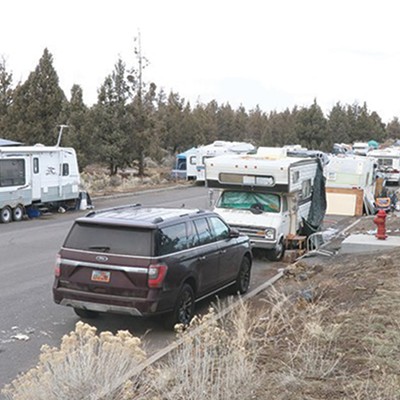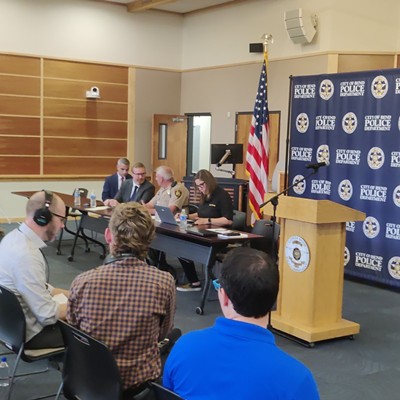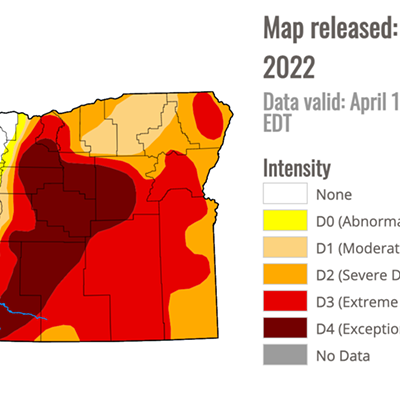Looking east from Bend's Pilot Butte, the large arrays of solar panels near Neff Road stand out. So do Oregon's major environment, energy and climate-related efforts, as they keep chugging along regardless of recent actions from the federal level.
To renewable energy proponents, the solar projects popping up around the Bend region offer a bright spot following an executive order and budget proposal from President Donald Trump in recent weeks that have called for scrapping certain environment-related policies and slashing resources for the federal agency that was created to protect the environment and human health.
"Oregon is as committed as ever to these things," said Cassandra Moseley, director of the Institute for a Sustainable Environment and of the Ecosystem Workforce Program at the University of Oregon. "If we try to find somewhat of a silver lining, you see Oregon trying to stay focused."
Executive Orders
Last month, Trump proposed a 2018 budget that would reduce EPA's budget by $2.6 billion, or 31 percent, and cut about 3,200 agency positions. Also in March, Trump issued an executive order emphasizing a national interest in promoting clean, safe development of the nation's energy resources ensuring affordable electricity and avoiding regulatory burdens that hinder energy production, economic growth and job creation. The order calls for executive agencies to review existing rules that may burden the development and use of U.S. energy resources. Agencies could then suspend, change or rescind those rules. The order calls for the review to pay particular attention to oil, natural gas, coal and nuclear energy resources.
Trump's order specifically calls for rescinding and revoking various Obama Administration executive orders, plans and reports related to energy and climate change. It calls for rescinding guidance for federal agencies to consider greenhouse gas emissions and climate change when conducting required environmental reviews of projects. It also specifically calls for reviewing the EPA's Clean Power Plan. That plan from former President Barack Obama would set the first national standards on carbon from power plants, in a bid to reduce greenhouse gas emissions.
A statement from the White House Office of the Press Secretary on Trump's executive order said that, "by revisiting the federal overreach on energy regulation, President Trump is returning power to the states—where it belongs."
Western Governors Chart Another Course
Responding to Trump's proposed rollback of the Clean Power Plan, Oregon Gov. Kate Brown, California Gov. Jerry Brown, Washington Gov. Jay Inslee and the mayors of Portland, Seattle, San Francisco, Oakland and Los Angeles jointly stated that they planned to "assert our own 21st Century leadership and chart a different course."
The West Coast leaders called climate change "one of our greatest threats," noting more resulting wildfires, ocean acidification that can harm the shellfish industry, and drought that can impact agriculture.
"Too much is at stake—from our health and safety to our jobs and livelihoods—for us to move backwards," the group said, adding that they planned to continue their efforts on clean energy and electrifying the transportation sector.
In a statement, U.S. Sen. Jeff Merkley, D-Oregon, said he planned to introduce legislation to map out a path to a 100 percent renewable energy system by 2050.
Solar Firms & Power Companies Continue to Lay Plans
West Coast elected officials aren't the only ones with plans.
In the Bend area, the push for renewable power continues. The Bend region already has a number of solar projects in the works, according to the nonprofit Renewable Northwest. There's Cypress Creek Renewables' two solar facilities producing 10 megawatts each off Bend's Neff Road. Bear Creek Solar Center LLC, part of Virginia-based Coronal Energy, continues plans to develop a 10-megawatt solar facility on about 90 acres nearby, just east of Bend, north of Highway 20 and south of Neff Road. Other area projects in various stages of development include Tumbleweed Solar along Highway 97 toward Redmond; the Empire Solar and Gala Solar facilities, each 56 megawatts, between Bend and Prineville; the 34-megawatt Ponderosa Solar, the 56-megawatt Tango Solar and the 55-megawatt Prineville Solar Energy, all closer to Prineville; and the Adams Solar Center and Elbe Solar Center, each 10 megawatts, near Madras.
Utilities are also planning for renewables and climate change. In a statement on the executive order, Portland General Electric noted that it has advocated for years to reduce carbon emissions at a reasonable cost, adding that Trump's executive order likely would not affect its operations.
"We feel strongly that climate change must be addressed at the national level. It is unfortunate that we are not moving forward as a nation to address this global problem," PGE stated. The utility still plans to stop using coal at its 575-megawatt plant in Boardman by the end of 2020 and is exploring the possibility of converting the plant to use biomass instead.
"PGE will continue to add renewable resources and reduce emissions to meet Oregon's ambitious clean energy standards, and we are on track to eliminate coal at our Boardman plant by the end of 2020," the utility stated. "This work will continue to move forward regardless of what happens at the federal level."
Meanwhile, Pacific Power, part of PacifiCorp, laid out a $3.5 billion long-term energy plan early this month that calls in part for more renewable energy resources over the next 20 years, including nearly 2,000 megawatts of new wind resources; about 900 megawatts of upgraded wind resources; and about 1,000 megawatts of new solar resources.
State efforts proceed
In March, Oregon's Department of Environmental Quality and the Oregon Health Authority released a draft framework to guide upcoming rules of the Cleaner Air Oregon program, started in 2016 after high levels of heavy metal toxins from glass manufacturing facilities turned up in the Portland area—despite the facilities' compliance with federal regulations.
"There's a gap in the current regulations," Joe Westersund, Cleaner Air Oregon coordinator at DEQ, said of rules for industrial air toxics.
Existing regulations are not based on the impact of emissions to human health. The new rules for industrial air toxics aim to do so. They will apply to stationary emission sources such as power plants, factories and manufacturing facilities, but DEQ continues determining which facilities may fall under the new rules. The program's funding will come largely from permit fees. It's unlikely that EPA budget or staff cuts would affect the effort, according to Westersund.
"We're a little more insulated," Westersund said of the program and the prospective cuts to EPA.
DEQ's advisory committee is meeting a few times through the spring to review the draft framework, a conceptual design of rules. DEQ will then draft rules and information on their fiscal impacts later this spring, followed by public comment. The Oregon Environmental Quality Commission, which oversees DEQ, could decide on the rules in spring 2018.
Meanwhile, a separate state effort to review the possibility of a cap-and-trade system in Oregon produced a report from DEQ in February.
The state legislature had asked the agency last year to check into how such a market-based approach might work in Oregon, as a way to help reduce greenhouse gas emissions. A cap-and-trade system limits emissions from sources like electric providers and industrial facilities with a cap and lets those emitters trade their allowances—permits for certain amounts of allowed emissions—in a market. DEQ's new report found that cap-and-trade would help the state limit emissions in a cost-effective way. The study did not consider benefits from reducing pollution, DEQ stated.
Oregon's other environment-related efforts also continue.
The state already has a Clean Fuels Program that seeks to reduce the carbon in transportation fuels over time through set standards. And Oregon had already adopted California's low-emissions vehicles standards, meant to reduce greenhouse gas emissions and other air pollution from vehicles over time. Using California's rules means that those limits remain in place even if federal rules change, DEQ has noted on its website. Oregon had also already adopted California's program that aims to increase the number of zero-emissions vehicles, such as electric vehicles, by requiring manufacturers to sell more of those types of vehicles in the state over time.
California gets a waiver from the EPA for those stricter emissions limits. Uncertainty now swirls around whether the EPA will again grant that waiver to ensure that California and states like Oregon that have adopted its stricter limits can continue their existing programs.
Colin McConnaha, senior climate policy advisor at Oregon DEQ, recently returned from a trip to Washington, D.C., where he talked with other states' officials about their various programs and goals, and the signals coming from the current Administration.
The denial of the waiver, for instance, would be a concern "if that was a credible threat," McConnaha said. But denying the waiver would need significant legal findings to support such a move. And that move would clash with the idea of states' rights—a notion championed in the past by new EPA Administrator Scott Pruitt.
"I think it's a long shot," McConnaha said of a denial.
He also noted that the Clean Power Plan—although it has the potential to impact the carbon levels of electricity for states—had not yet taken effect anyway, due to a court challenge. Since there was no state strategy to implement it, Trump's executive order to review the Clean Power Plan doesn't actually halt it any further.
"It just really adds to the already high level of uncertainty," McConnaha said of the order.
State law is the driving force for controlling carbon emissions in Oregon anyway, he noted. Oregon already has targets for boosting renewable energy – 50 percent by 2050 – and for divesting Oregon utility ratepayers from coal-fired generation by 2035. Such state efforts will continue regardless of executive orders, McConnaha said.
So would any cap-and-trade system, if Oregon chooses that route.
"Oregon's potential pursuit of implementing a cap-and-trade program is largely unaffected by possible changes in federal regulations," McConnaha said in an email.
The road ahead
Moseley, of the University of Oregon, expects to see more state and local efforts and experiments on environment issues. She also expects to see lawsuits over Trump's executive order that target rules based on law and policy that remain intact. For instance, the provision in Trump's order rescinding guidance for federal agencies to consider greenhouse gas emissions and climate change when conducting required environmental reviews of projects will likely spark a lawsuit as soon as an agency tries to skip that step.
Char Miller, an environmental analysis professor at Pomona College who has written several books about environment issues in the West, also expects lawsuits over the executive order's rollback of the requirement for a review of climate change implications. Those projects take place in states, Miller noted, adding that he could not imagine courts saying that, "the states don't have the right to protect their citizens' health and well-being."
Miller suspects that Trump's recent moves on environment issues have turned many citizens and groups into states' rights advocates. And he expects states themselves, not just environmental organizations, to play leading roles in lawsuits.
"A lot of this is going to play out in the judicial system," Miller said.
Miller pointed to the huge outdoor recreation and renewable energy industries, plus the long-standing citizen and political desire in western states supporting environment issues and renewable energy, as driving forces. But cuts to the EPA's budget and staff could hinder that agency from enforcing environmental regulations.
"Which is why it's up to the states to push forward," Miller said.
"This is just the opening act of a multi-act play," Moseley said, noting that other acts will involve Congress, federal budgets and court cases. "There's a long road ahead."
Additional sources:
https://www.whitehouse.gov/the-press-office/2017/03/28/presidential-executive-order-promoting-energy-independence-and-economi-1
https://www.whitehouse.gov/sites/whitehouse.gov/files/omb/budget/fy2018/2018_blueprint.pdf

























